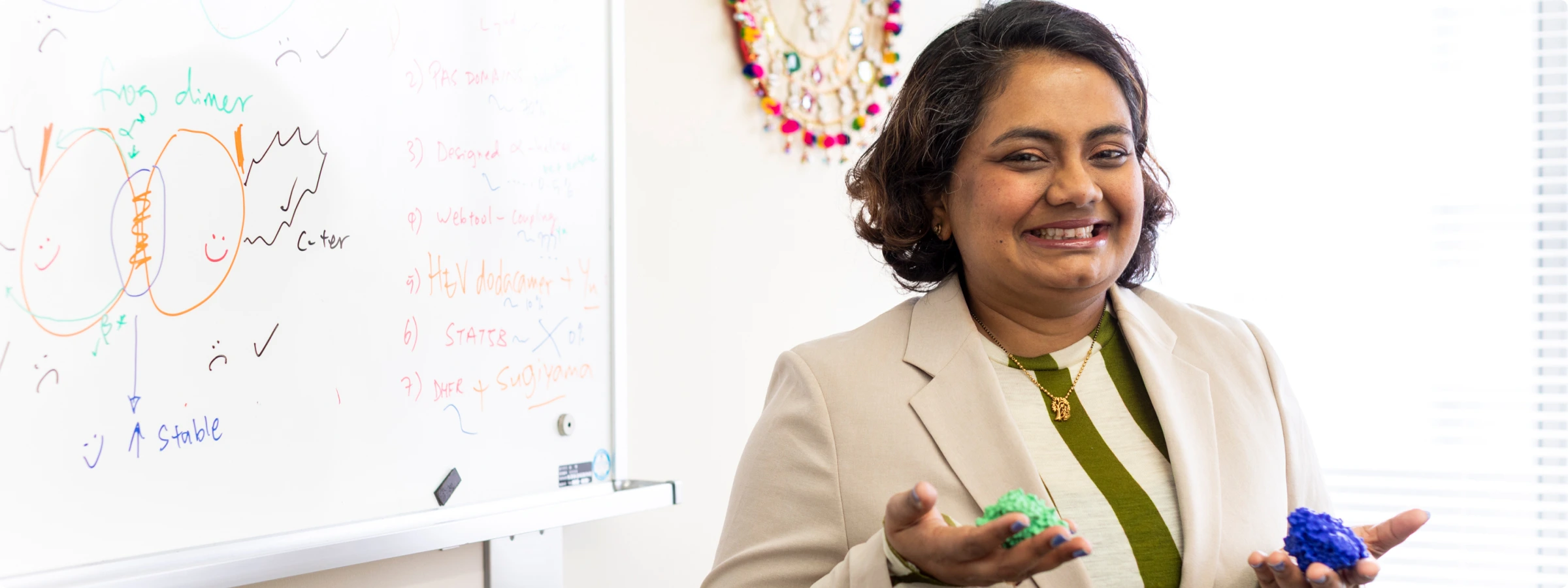Researcher
Sandhya P. Tiwari
- 所属:
- 大阪大学 蛋白質研究所 生体分子動態モデリング研究室 准教授
- 研究内容:
- Discovering biologically relevant dynamics of protein structures through computational modeling and simulations

About your research
Our goal is to model the dynamic motions of biomolecules, mainly proteins, and explore their role in biological function. By integrating existing biophysical and structural data, we model biomolecular structure and dynamics using a variety of computational methods.
Q&A

What are the unique aspects or strengths of your research?
The core expertise of the laboratory lies in structural bioinformatics, coarse-grained elastic network models and molecular dynamics simulations. Our research is focused on studying the overall conformational dynamics of proteins in response to mutations or ligand binding. As part of our general methodology, we integrate large structural and biophysical experimental data to study functional mechanisms by comparing changes to protein flexibility and the overall conservation of dynamics.
How do you think the results of your research will benefit society or industry?
The methods refined and the results produced from our research can impact our fundamental understanding of proteins as flexible entities, with mechanical properties. As such, more work can deepen our understanding on how large assemblies impact catalytic function, how intermolecular interactions affect the intrinsic flexibility of a protein as well as the dynamic signatures that should be preserved when designing novel proteins. For example, one of our projects involves characterizing the dynamics of leukotriene alpha-4 hydrolase (LTA4H), an enzyme implicated in chronic inflammatory diseases, while another addresses the impact of mutations in the coiled-coil domain of STAT5B, a transcription factor implicated in growth deficiencies and cancer.
How is data science utilized in your research?
Data science is fundamental to our research. From the assembly of structural data that is publicly available in the Protein DataBank (PDBj) to the calculation of normal modes from elastic network models derived from protein structures, and dimension reduction when analyzing vast amounts of molecular dynamics simulations data, data science is part of our daily routine!
Please share examples of collaborative research or the potential for future collaborations.
Currently the laboratory is engaged in collaborations internally at IPR, domestically and internationally.
- Cryo-EM determination of leukotriene alpha-4 hydrolase and comparative molecular dynamics analysis (internal; Laboratory for High Resolution Cryo-EM, PDBj)
- Analysis of alpha-helical flexibility in Globin-like proteins (internal; Laboratory for Protein Design)
- Impact of mutations in the coiled-coil domain of STAT5B on nuclear localization (domestic; WPI-PRIMe, Osaka University)
- Coupled motions of PAS domains in CLOCK proteins (international; Indian Institute of Technology, Gandhinagar, India)
What are the prospects and goals for your research?
We aim to promote the inclusion of dynamics in the large-scale analysis of proteins, to better understand their functional behavior and improve predictive power.
Selected papers
- K. Sudarsanam,A. Srivastava, S. P. Tiwari, Comparing PAS domain-coupled intrinsic dynamics
in bHLH-PAS domain transcription factor complexes, Biophy J, 125, 1–12 (2026).
https://doi.org/10.1016/j.bpj.2025.10.038 - B. Dasgupta and S. P. Tiwari, Explicit versus implicit consideration of binding partners in protein–protein complex to elucidate intrinsic dynamics, Biophys Rev, 14(6), 1379-1392 (2022).
https://doi.org/10.1007/s12551-022-01026-5 - S. P. Tiwari, F. Tama and O. Miyashita, Protocol for retrieving three-dimensional biological shapes for a few xfel single-particle diffraction patterns, Journal of Chemical Information and Modeling, 61(8), 4108-4119 (2021).
https://doi.org/10.1021/acs.jcim.1c00602 - S. P. Tiwari, S. Chhabra, F. Tama and O. Miyashita, Computational protocol for assessing the optimal pixel size to improve the accuracy of single-particle cryo-electron microscopy maps, J. Chem. Inf. Model., 60(5), 2570-2580 (2020).
https://doi.org/10.1021/acs.jcim.9b01107 - S. P. Tiwari and N. Reuter, Similarity in shape reveals signature intrinsic dynamics despite low functional conservation in enzymes with the TIM barrel fold, PLoS Comp. Biol., 12(3), e1004834 (2016).
https://doi.org/10.1371/journal.pcbi.1004834 - T. Perica, Y. Kondo, S. P. Tiwari, S. H. McLaughlin, K. R. Kemplen, X. Zhang, … S. A. Teichmann, Evolution of oligomeric state through allosteric pathways that mimic ligand binding, Science, 346(6216), 1254346 (2014).
https://doi.org/10.1126/science.1254346
